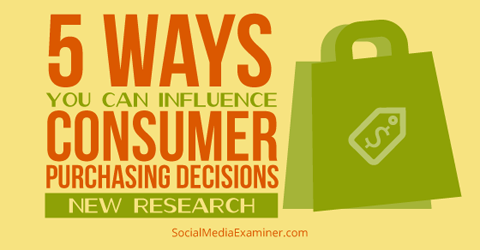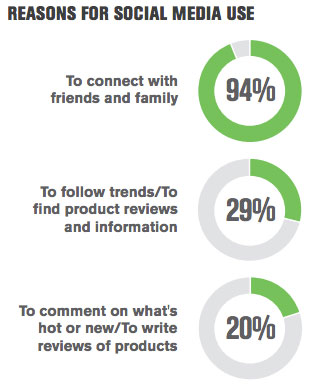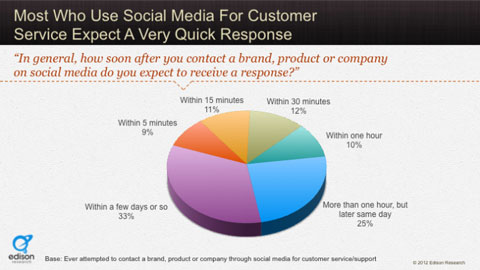 Are you wondering whether social media has any real impact on consumer purchasing decisions?
Are you wondering whether social media has any real impact on consumer purchasing decisions?
Do you sometimes question the potential of social media marketing?
Most businesses and organizations dive into social media hoping to increase brand awareness and acquire more customers. Many are disappointed when it doesn't pan out.
In this article I'll share five ways you can adjust your social media tactics to improve your brand's influence on consumer purchasing decisions.

#1: Change Social Conversations
A recent Gallup poll published in the State of the American Consumer report indicates that despite the tremendous number of Americans using social media platforms, only 5% say those platforms have a great deal of influence on their purchasing decisions. Worse still, 62% say social media has no influence at all!
What's the problem? Businesses think they can use social media to influence or change the way consumers think. The toughest lesson for businesses is learning to use social media channels the way consumers want to use them, not the way the business wants to use them.

Consumers use social media to make conversation and connections. Time and again, research has shown that consumers use social media primarily to connect with family and friends, follow trends and find product reviews or information. They also comment on what's hot or new and write reviews about products.
Since the 2008 recession, consumers have become more skeptical of businesses and more cautious with their own spending. Hence, it's highly unlikely that businesses influence consumers' purchasing behavior simply by talking about themselves and their products on Facebook.

The only way to motivate your social media audience and convert them into customers is to change the conversation and engage fully with your existing audience—you have to inspire them to advocate on your behalf.
If social media users perceive your messages and intentions as sincere, they will engage with you. But if they suspect you're trying to market to them, they will hide your content or permanently block you from their feeds.
The bottom line is that social media isn't primarily about driving sales or influencing consumers' purchasing decisions. If that's what you bought into, you're going to be disappointed. Social media marketing is about making emotional connections through positive customer experiences, exceptional service and engaging conversations.
#2: Appeal to Millennials
The Gallup poll I mentioned in the previous section shows that Millennials in particular—a key social media audience—aren't easily influenced by social media. Only 7% say social has a great deal of influence on purchasing decisions, while 48% say it has no influence at all.

To influence Millennials via social media, companies have to understand how that demographic consumes information, and then identify how to deliver a marketing message that appeals to them.
Get World-Class Marketing Training — All Year Long!
Are you facing doubt, uncertainty, or overwhelm? The Social Media Marketing Society can help.
Each month, you’ll receive training from trusted marketing experts, covering everything from AI to organic social marketing. When you join, you’ll also get immediate access to:
- A library of 100+ marketing trainings
- A community of like-minded marketers
- Monthly online community meetups
- Relevant news and trends updates
Millennials are hyper-connected and consume content on multiple platforms and devices. While they're enthusiastic about honest, authentic marketing, they want to be in charge of the conversations. They're uninterested in the opinions of those outside their social group, but super-interested in what their friends think.
Based on the Razorfish Liminal report, you can win over Millennials by creating mobile-friendly content that fits their needs and preferences—don't waste their time with generic messages. If you're not sure what they're looking for, ask them.

Discover Proven Marketing Strategies and Tips
Want to go even deeper with your marketing? Check out the Social Media Marketing Podcast! Publishing weekly since 2012, the Social Media Marketing Podcast helps you navigate the constantly changing marketing jungle, with expert interviews from marketing pros.
But don’t let the name fool you. This show is about a lot more than just social media marketing. With over 600 episodes and millions of downloads each year, this show has been a trusted source for marketers for well over a decade.
You can build trust with Millennials by showing there's no clash between policy and practice. For example, if your company's Twitter bio says you follow back everyone who follows you, be sure to do exactly that. If something goes wrong with your product or service, apologize publicly on social networks (particularly YouTube).
#3: Engage Customers Offline and Online
Social media doesn't function in a vacuum. If you want to influence consumers, you must engage with them both online and offline. Gallup polls consistently find that customer engagement depends largely on how well an organization aligns all of its touch points.

For example, in the USA, Dr. Pepper encourages customers to create their own t-shirts as a way to join in the fun of their promotional campaigns. They're turning customers into brand advocates through online offerings that translate offline.
While it's easier for some industries to leverage both offline and online customer engagement, the key is to understand your brand's emotional connection with consumers and act upon it. If you don't know what the emotional connection is, the best thing to do is ask your audience.
#4: Start Authentic Facebook Conversations
Social media is highly personal for consumers—they want to interact with other people, not with brands. Consumers are more likely to respond to companies that are personable and genuine.
Here's an example of how ADT uses their Facebook page to talk with consumers not at them:

Notice how this post focuses on an issue that is highly personal, and literally close to home for American homeowners. Instead of pushing their product, ADT offers helpful information.
The lesson for businesses (especially larger corporate brands) is to back off from hard-sell techniques and focus on open dialogue with consumers.
#5: Be Available at All Times
Because social media is 24/7, consumers have come to expect immediate responses from brands—even nights and weekends!
Research shows that 42% of consumers who complain on social media expect a response within 60 minutes. Further, 57% expect the same response time at night and on weekends—even if it's not during normal business hours.
Is your brand equipped to handle those expectations?

You can scale your customer service with social media. For example, while one customer service agent is talking to a customer on the phone, another agent can respond to several inquiries via social media.
Another option is to launch an online community to enable customers to help each other. Within that community, you'll likely find some members who are more engaged and helpful than others—they consistently go the extra mile to help other customers solve their problems. Create an advocacy program to reward (and retain) those people.
Help customers help themselves by offering how-to articles on your blog or website. Make the information easy to find with links on your social profiles and other marketing materials. If customers can solve a problem themselves, it reduces the need to pick up the phone or tweet a reply.
Finally, you're probably monitoring social mentions already. Continue to do that—customers are a key source of information when your product isn't working. Listen for negative feedback and reply accordingly.
Over to You
If you've been using social media marketing for even a short period of time, you've likely realized that consumers are good at tuning out brand-related content on Facebook and Twitter. You know that social media by itself could never motivate a fan or follower to recommend your brand to others, let alone purchase your products.
But that doesn't mean you can't change the conversation. Concentrate on what social media audiences want instead of what you want. You'll likely find more success by catering to customers' expectations and habits.
What do you think? Have you used any of these tactics to influence consumers through social media? What was your experience? Please share in the comment box below.
Attention Agency Owners, Brand Marketers, and Consultants

Introducing the Marketing Agency Show–our newest podcast designed to explore the struggles of agency marketers.
Join show host and agency owner, Brooke Sellas, as she interviews agency marketers and digs deep into their biggest challenges. Explore topics like navigating rough economic times, leveraging AI, service diversification, client acquisition, and much more.
Just pull up your favorite podcast app, search for Marketing Agency Show and start listening. Or click the button below for more information.

